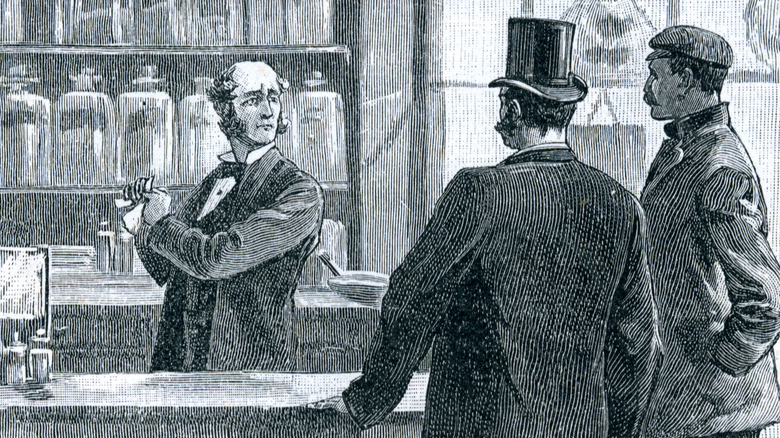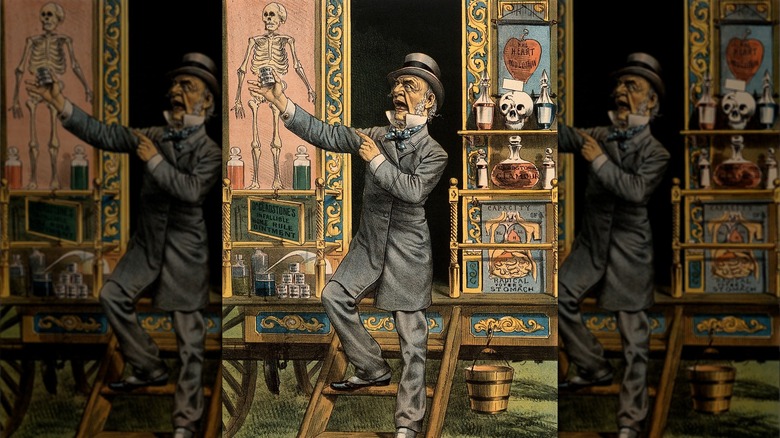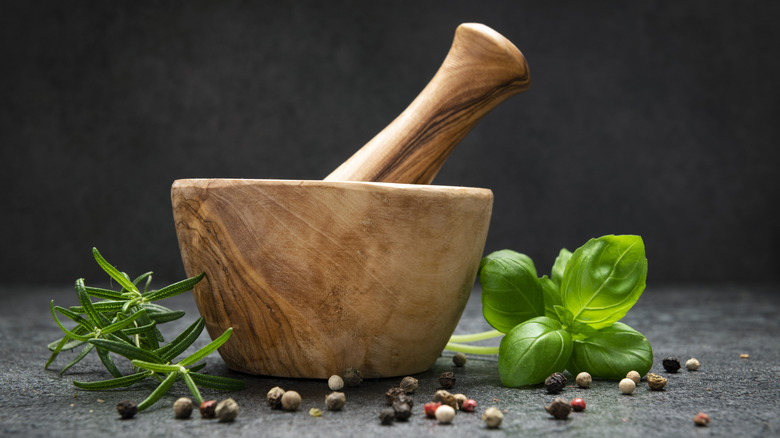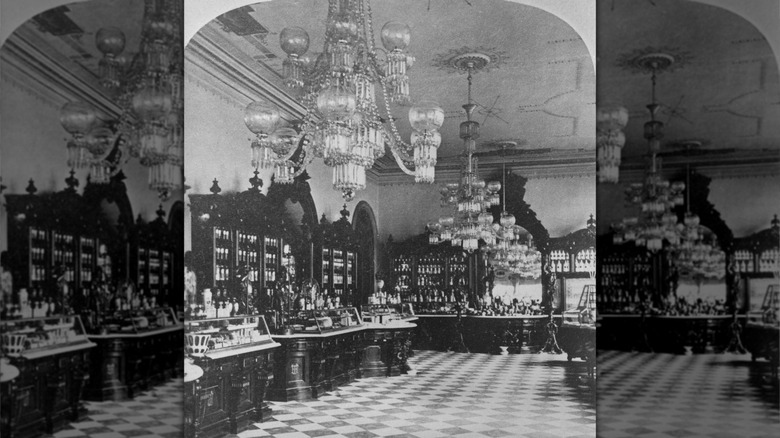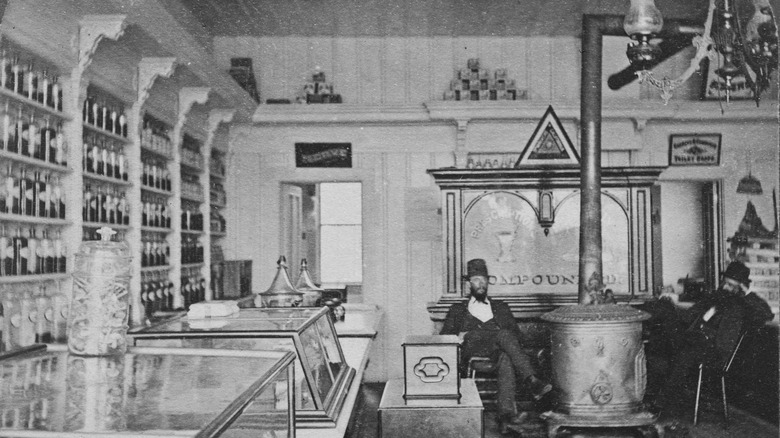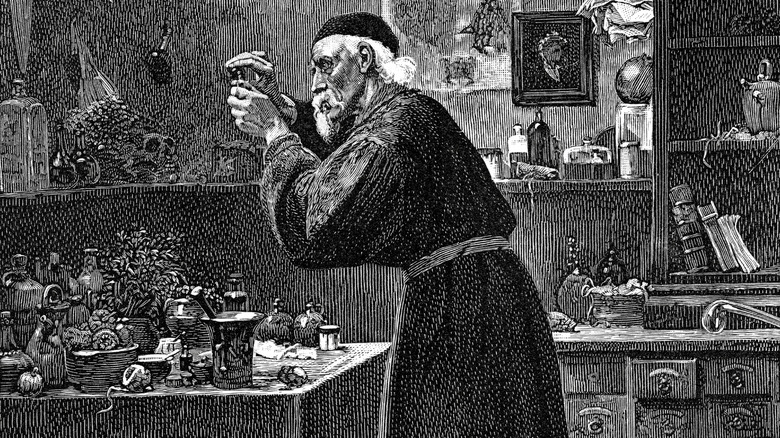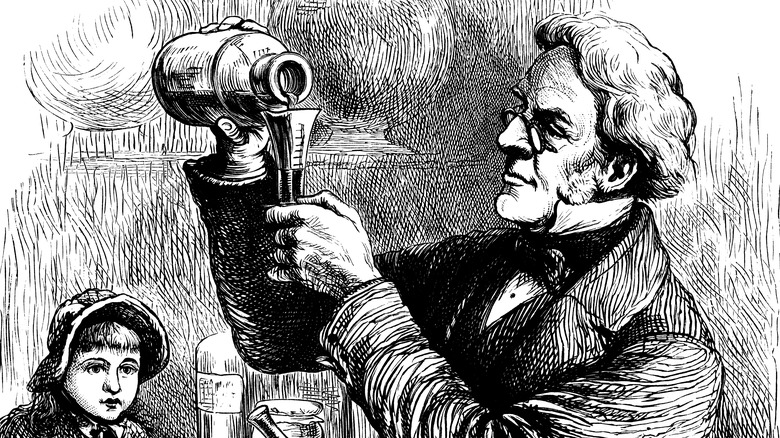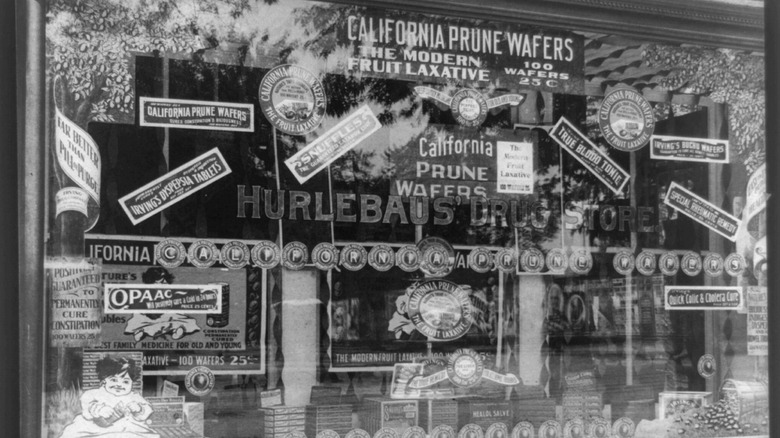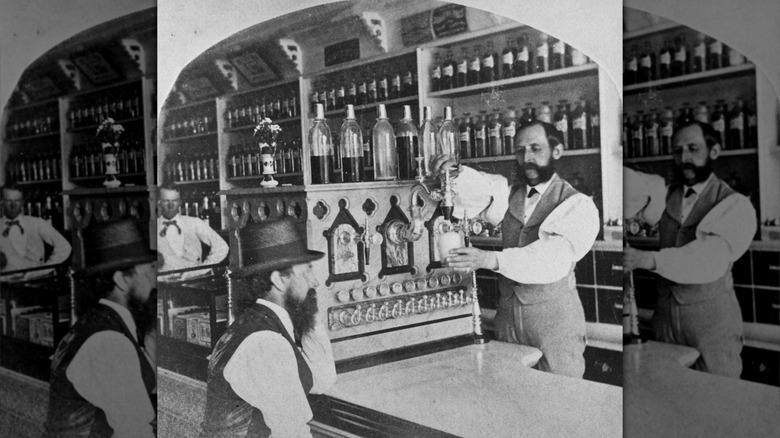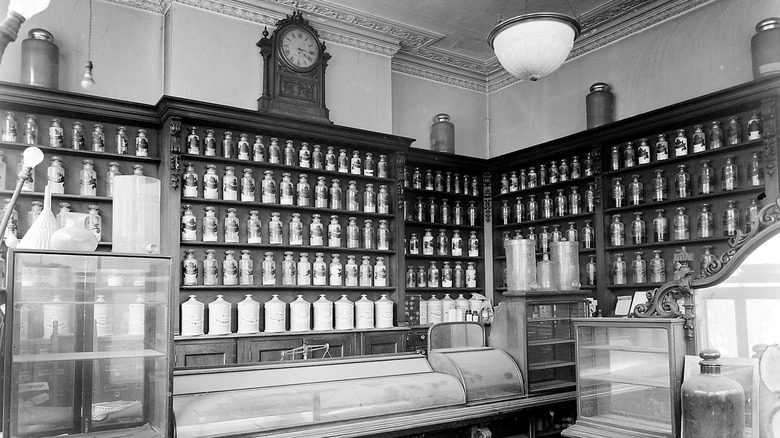What 19th-Century American Pharmacies Were Really Like
Everyone today has a pretty good idea of what the medical field looks like, but if you go back in time, it was very different. The science behind medical conditions wasn't well understood, and neither were the inner workings of human anatomy. People believed some bizarre things about medicine, and medical treatments would have looked pretty odd to the modern eye. Medicine often revolved around the idea of four "humors," or four different fluids that were thought to exist in the body. Illnesses were ascribed to those four substances — blood, phlegm, yellow bile, and black bile — being out of balance, and so treatments were meant to bring the humors back into equilibrium.
That was the prevailing idea behind medicine for quite a while, and it led to some strange treatments. (If you've ever wondered why leeches were such a big thing in the past, well, this is your answer.) But as the 19th century rolled around, the fundamental ideas behind medicine and anatomy began to shift toward something more familiar to modern sensibilities, and pharmacies sprung up to fill the new needs — and prescriptions — of the public.
Still, the pharmacies of the 19th century weren't quite like the drugstores of today. Sure, the beginnings of modern pharmacy were there, but there were certainly some quirks unique to the time period. Here's a taste of the pharmacy experience back in 1800s America.
There wasn't much regulation in the early 19th century
Back in the 19th century, pharmacy was a relatively new practice, but, speaking generally, there were quite a few superficial similarities between pharmaceutical practices in Europe and the U.S. However, when you dig a bit deeper, especially in America, there were actually a lot of smaller differences between individual pharmacies.
The reason for that? Unlike in Europe, American society has typically been rather averse to the idea of nationwide regulation. That general feeling bled into the pharmaceutical field, and there wouldn't be any sort of legal action taken toward regulating the industry until the latter half of the 19th century. As a result, until that point in time, pharmacy was sort of a practice where anything goes. Anyone could open a pharmacy, and they could do so with very little official certification, so long as they'd had an apprenticeship beforehand (or $50 to spend on a fancy diploma). The actual definition of a pharmacy was also still in flux, with their functions often overlapping with the apothecaries of the past, as well as other businesses such as local general stores. Ultimately, in some cases, pharmacies couldn't really be depended on for legitimate cures, and pharmacists could turn out to be little more than snake oil salesmen.
The 19th century did eventually see the formation of dedicated schools of pharmacy, as well as official institutions like the American Pharmaceutical Association, though it took some time for real regulation to set in and make a difference.
Pharmacies had specific symbols so they could stand out
As explained by Pharmacy in History, the actual buildings used by pharmacies typically weren't all that distinctive. After all, pharmacies don't exist in a vacuum, separate from the rest of the city, and their facades were made to match those of the buildings all around them. So how did pharmacists make their shops stand out, and how did potential customers know just which building was the pharmacy?
Pharmacies had a couple of symbols or icons that represented them. One of them, rather fittingly, was the mortar and pestle that pharmacists made regular use of — or attached to the outer wall of their storefront, clearly on display for any wandering passersby. Other times, just a picture of a mortar and pestle was enough to get the point across, or pharmacists would have the image etched into the glass of the windows. Aside from that, though, there was another item closely associated with pharmacies: the show globe. Essentially, these show globes were glass bottles filled with brightly colored water. The eye-catching vessels made for excellent window displays when lined up next to each other, and they became the other widely recognized symbol for pharmacies.
Pharmacies had impressive interiors
Pharmacies of the 19th century were designed to impress, especially when it came to their interiors. Despite pharmacies being a place to pick up medicines and deal with illnesses — not exactly the most joyful of situations — they were often designed to look spacious and almost luxurious, with plenty of open, public areas. When it came to the larger shops, things could get even more glamorous. Fancy displays, carvings, or statues could be found on the floors of the pharmacy, not to mention the ubiquitous soda fountain. Chandeliers could be found hanging from the ceilings of the fanciest pharmacies. But even on the smaller scale, care was taken to make these stores look classy, with hand-cut glass bowls often kept on the shelves, holding mountains of candy to draw in the crowds.
But perhaps the most recognizable feature of a pharmacy's decor was the glass bottle. Or, to be more accurate, a whole lot of glass bottles and jars. Photos on History depict shelves built into all the walls of the shop, with bottles of all different sizes and colors proudly lined up on them, holding various kinds of liquids or general ingredients for medicines — a strange mix of imposing and impressive, really.
Pharmacies were often more than one thing
When it comes to pharmacies, the first thing you think of is probably shops with plenty of different medicines on offer. And that would be true in the present day, but in the past, pharmacies could fulfill a whole slew of needs.
In the 19th century, there were some pretty blurry lines when it came to what exactly defined a pharmacist, and pharmacists also billed themselves as chemists, apothecaries, druggists, or some combination of those titles, such as "druggist and pharmaceutical chemist," per Pharmacy in History. At times, the pharmacy would even just be a small building annexed to a physician's office, effectively a one-stop shop for all your medical needs.
But there were a number of other interesting combinations. Some pharmacies were actually, effectively, two stores stitched together, with the pharmacy section on one side and something entirely different on the other. As for what you could buy from the other half of the store? General goods like groceries might be available, but in stranger cases, you could shop for jewelry, watches, or even pianos at your local pharmacy.
The many jobs of a 19th-century pharmacist
From a customer's point of view, walking into a pharmacy could mean you were there to buy anything from medicine to a piano. But it could also mean you were there for a wide range of different services, too, because pharmacists wore a lot of different hats. And that's beyond just the technicality of whether pharmacists could or should be considered chemists.
Generally speaking, there were a number of times in the past when pharmacists could also double as practitioners of many other medical disciplines. Sometimes, they would also offer services as an optometrist, and other times, they could even act as dentists.
Most commonly, though, pharmacists also acted as physicians. In the modern day, the two professions are kept completely separate, but in the 19th century, most people could go to a pharmacist not just for medicines, but for diagnoses as well. They were effectively doctors in their own rights, and that could put them on the frontlines when it came to disease treatment. As a result of their skill sets — and the overlap between pharmacist and physician — they would be among the first to learn exactly what illnesses were affecting the local community, and the first to figure out how to treat those illnesses.
Pharmacists made their own medicines
Nowadays, when you walk into a pharmacy, you're sure to find shelves and racks stocked with mass-produced drugs that are available to just about every drugstore. There's very little variation in the medications that you can pick up. But back in the 19th century, that was nowhere near the case.
Instead, pharmacists often made their own unique medicines using formulas and processes that were specific to them. They kept stores of different kinds of plants, insects, and minerals, as well as all the necessary equipment to mix and package their medications on the spot. Mortars and pestles were staples of the pharmacist's arsenal, used to crush and combine whatever ingredients they needed to make a particular cure. Then there were also all the means to turn that crushed-up substance into something that a patient could use; pills, plasters, capsules, and injections were just a few forms that the medication could take, and pharmacists were perfectly capable of putting that together from the comfort of their own shops.
In fact, most pharmacists had more than just their storefront; many of them had a small room where they could go and make the cures they were selling. Unfortunately, there aren't many surviving records of exactly what those workrooms — or "prescription rooms" — looked like. After all, they weren't often pictured or advertised, though it seems like a safe bet to think they might have been pretty messy (and, thus, not especially photogenic).
There was plenty of advertising to be seen
Given that it wasn't unheard of for pharmacies in the 19th century to sell sham medications that were little more than snake oil, it sure seems like they were heavily geared toward the idea of ensuring profits. And where profits are concerned, advertising is never too hard to find; this was true when it came to 19th-century pharmacies as well.
Both the interior and the exterior of pharmacies made for a good canvas for those ads, with their owners usually plastering signs across the windows and awnings to draw people in, or along the walls and counters to convince customers of what to buy. Typically, those ads would depict the general goods or toiletries that could be found on hand, but many pharmacists also made sure to liberally advertise the proprietary drugs they had on offer. After all, pharmacists back then made their own cures, so they could make claims to having better products than their competitors. Advertising them was just that much of a competitive edge, especially when they went the extra mile to get shiny lithographic prints put together just for the purpose.
Soda fountains were everywhere
If there's one thing that you might be familiar with when it comes to pharmacies and shops of the 19th century (and even the early 20th century), it's probably those vintage soda fountains. And there's a really good reason for that, because soda fountains were, in fact, a staple of 19th-century American pharmacies.
Part of that came from the fact that soda fountains were, simply put, a good way to attract more people; pharmacies were businesses first and foremost, after all. They could be installed on counters, inviting customers to linger and take a drink, or they could be placed in the middle of the room, a freestanding centerpiece kept on display. Either way, they doubled as excellent advertisements, with images depicting families happily enjoying sodas during their visit to the pharmacy.
But soda was more than just an advertising ploy. At that time, soda was believed to have medicinal purposes, which had actually been touted as early as 1767, when the fizzy drink was first invented. So soda fountains and pharmacies were quite the natural fit for each other, with pharmacists putting their own spin on simple carbonated water by adding in other ingredients thought to have health benefits. Sure, those additives did range from sugar and flavorings to heroin and cocaine, but the drinks were selling, even to the point that those concoctions have since become household names. Coca-cola, Pepsi, and 7-Up are just a few of today's sodas with roots in 19th-century pharmacies.
The available drugs weren't what you'd see today
When you think about modern pharmacies, the drugs that come to mind are most likely prescription medicines with complicated names. But the word "drugs" can also conjure a very different image — one you probably don't associate heavily with the medical field. In the 19th century, though, there wasn't much of a difference.
Basically, if you wanted a little opium, you could get that from your local pharmacy. The same went for morphine and heroin, along with a whole host of other drugs that definitely wouldn't be offered over the counter in the 21st century. For that matter, pharmacy sodas were sometimes laced with similar drugs; cocaine in particular was heralded as a miraculous and safe stimulant that could easily be added to those sodas. All of those drugs just weren't seen as dangerous at the time, and they were just considered normal medication, acting as painkillers, stimulants, or even anti-diarrheals. The science of addiction was yet to be studied, and even when researchers began looking into it around the turn of the 20th century, pharmacies continued to sell addictive drugs. Dubious morals aside, addictive habits could keep customers coming back for more.
Hard drugs weren't the only things on offer, though. Medical science was still evolving, which meant that some old practices persisted. Of particular note was the fact that some pharmacies had leeches on offer, which could be purchased and taken to a physician for the old technique of bloodletting.
[Featured image by Wellcome via Wikimedia Commons | Cropped and scaled | CC By 4.0]
